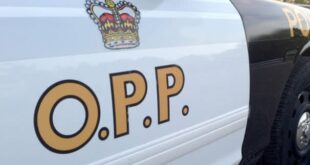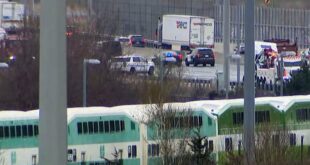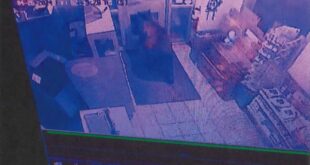Residents were ordered to leave on Aug. 16

Residents of Yellowknife, Ndilǫ, Dettah and the Ingraham Trail will be able to go home starting at noon on Wednesday, three weeks after the territory issued an evacuation order for these communities due to an approaching wildfire.
The city, along with the Yellowknives Dene First Nation (YKDFN), issued a joint plan that states that the city and the YKDFN will ask the department of Municipal and Community Affairs (MACA) to change the evacuation order to an alert at noon on Wednesday. The plan includes keeping all three communities under an evacuation alert starting that day.
Most essential workers will begin returning home on Monday and Tuesday, said the city in a Facebook post on Friday evening. The post said the Wednesday return date for the general public is dependent on weather conditions.
In an emailed statement, MACA Minister Shane Thompson said the territorial government will work to ensure basic services are available when residents return.
He also acknowledged Friday's announcement may "strain" Alberta's resources as thousands of residents drive through the northern part of the province.

Wildfires have closed the highway connecting N.W.T. to Alberta
Wildfires have closed a section of highway in the Northwest Territories running to the Alberta border, as the worst fire season on record continues to threaten and cut off communities. In B.C., those who have lost their homes have started to tour through their burned-down neighbourhoods.
Stay where you are until order lifts, says MACA minister
Thompson asked the general public to remain where they are until the evacuation order lifts on Wednesday.
"No supports are available in Northern Alberta for residents considering moving north to wait for the order to be lifted."
The N.W.T. department of Infrastructure said Friday morning that Highway 1 would only be open to essential travel starting 7 p.m. on Friday.
In an earlier post, the department said the highway was expected to close to all traffic from Friday until Sunday, due to severe weather.

N.W.T. wildfire evacuees excited, relieved to return home
Evacuees at the Expo Centre in Edmonton react to news that they will be able to go home to N.W.T. on Sept. 6, three weeks after the territory issued an evacuation order for Yellowknife and neighbouring communities due to an approaching wildfire.
The evacuation of about 22,000 people from Yellowknife and neighbouring communities was ordered on Aug. 16. Displaced residents have found refuge across Alberta, Winnipeg, B.C., the Yukon and even further afield.
The wildfire that caused the evacuation remains about 15 kilometres from Yellowknife and has been declared as "being held."
Officials announced a phased re-entry plan for Yellowknife on Aug. 28 that would see essential workers in municipal services, grocery stores and health care, among other areas, return and prepare basic services for residents.
That plan was delayed heading into the September long weekend as strong, gusty winds were expected to close Highway 1 in the territory's South Slave region.
Friday's return plan also included a breakdown of what is considered essential. This includes:
- Pharmacy
- Transportation
- Municipal/band critical services
- Airport
- Utilities (including power, heat, water/sewer and garbage)
- Fuel services
- Child care providers for essential staff
- Indigenous elder services
- Grocery
Property owners returning to Yellowknife, Dettah and Ndilǫ are being asked to FireSmart their property to reduce the risk of wildfires, according to the plan.
Schools and health care
The boards representing all of the Yellowknife schools issued an unsigned letter to parents on Friday that said schools will not be opening by Sept. 11.
The letter was issued before the city announced the date for the return to Yellowknife, and said school officials are "awaiting further information about the re-entry schedule."
The Northwest Territories Health and Social Services Authority announced earlier in the day that once the evacuation order ends, residents should expect limited health care services.
A news release said that there would be no intensive care unit, obstetrics unit, pediatric services, chemotherapy, dialysis or IV therapy, and limited surgical services.
The city and YKDFN's plan said those with special care needs, including long-term health care patients and assisted living residents, are advised not to return while the communities are under an evacuation alert.
Evacuation ordered Aug. 16
A wildfire between Yellowknife and Behchokǫ̀ has been burning since late June. It previously forced the evacuation of Behchokǫ̀, ultimately damaging four homes in that community and another 15 structures along the Highway 3.
In early August, the fire began encroaching upon Yellowknife. Residents along the highway played the proverbial canaries in the coal mine as officials issued alert after alert of their possible evacuation while the fire moved closer to the city's boundaries.
The fire also forced multiple closures of Highway 3.
In the weeks prior to Aug. 16, city officials gave few details of what a full-scale evacuation of the N.W.T. capital would look like, other than to say they'd work with the territorial and federal governments.
On the evening of Aug. 16, with the fire about 17 kilometres from Yellowknife, officials announced a full-scale evacuation of the territory's capital, Ndilǫ, Dettah and the Ingraham Trail. They told residents they had until noon on Aug. 18 to leave.
Residents recounted driving through bumper-to-bumper traffic along the single, two-lane highway out of town, some through heavy smoke and nearby flames.
Others tried to catch an evacuation flight. After hours-long delays, many had to wait through the night to get on a plane.
Other communities still waiting to go home
Several communities in the N.W.T.'s South Slave region were put under evacuation orders before Yellowknife — also due to massive, nearby wildfires — including Hay River, Kátł'odeeche First Nation, Enterprise, Kakisa and Fort Smith.
People from those communities are still waiting for word on when they can go home. Several won't have homes to go back to.
On Friday, Minister Thompson said that given the limited services that will be available in Yellowknife when residents return, no evacuation centres or other accommodations will be open in the city to evacuees from other communities.
With Yellowknife evacuated, about two-thirds of the N.W.T.'s population have been displaced due to wildfires.
This wildfire season is expected to be the worst on record in terms of total burn area — upwards of 3.5 million hectares so far — and financial cost.
*****
Credit belongs to : www.cbc.ca
 Atin Ito First Filipino Community Newspaper in Ontario
Atin Ito First Filipino Community Newspaper in Ontario






